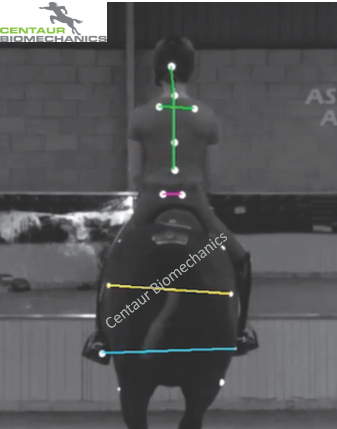
Riders attempt to be positioned on the horse symmetrically; however, this is sometimes challenging due to the rider’s skill level, functional asymmetries, perception, and pre-existing or historic injuries which the rider may have. Previous blogs have highlighted the effect that tack, and equipment have on quine locomotion. In the case of the rider what effect does rider asymmetry have on equine locomotion? As previously discussed, horses will develop a locomotor strategy to compensate to alleviate any discomfort and/or imbalance, in this case caused by the asymmetric rider.
Previously we have demonstrated the immediate effect that rider asymmetry has on the equine locomotor system when in trot. This was achieved by shortening one stirrup by 5cm which induced a measurable about of rider asymmetry (1). Using motion capture and inertial measuring units, the horse’s limb and back movement was quantified. Horses will develop a locomotor strategy to compensate and alleviate any discomfort. As a result of the asymmetric rider, this compensation strategy was evident with changes in back movement and limb loading (1). With the asymmetric rider the horses back movement altered with an increased range of motion which could be an indication of instability as opposed to dynamic stability. In addition to the changes in back movement, limb loading (derived from fetlock extension) front and hind was increased (overloaded) – interestingly, only the limbs on the opposite side to the shortened stirrup were affected therefore, one side of the horse has increased limb loading compared to the other (1).
Rider asymmetry not only affects equine locomotion but also saddle pressure distribution (2). In sitting trot, riders who collapse through one hip have been shown to increase saddle pressures beneath the saddle on the opposite side to the collapse (i.e. collapse of the right hip = increased saddle pressures beneath the left side of the saddle) (2) and riders who lean too one side with their trunk, result in an increase in saddle pressures on the same side as the rider is leaning too (2). Riders who lean forward, as maybe expected will increase saddle pressures in the front region of the saddle (3).
Rider asymmetry influences equine locomotion (1) and saddle pressures (2) which may lead to locomotor compensation strategies. It is accepted that humans (and horses) have some degree of asymmetry, laterality and handedness however, attempts should be made to help optimise rider biomechanics / symmetry in order to optimise the horse-saddle-rider interaction. It is appreciated that some riders are asymmetric as a result of skill level, functional asymmetries, perception, and pre-existing or historic injuries, in these cases, it is essential that the horse+rider are managed as a team in order to monitor and manage any locomotor compensation strategies which if left could manifest into long term compensations strategies.
Please like / follow our page for more blogs and please share to raise awareness.
Dr. Russell MacKechnie-Guire
Centaur Biomechanics
www.centaurbiomechanics.co.uk
equineresearch #biomechanics #centaurbiomechanics #veterinarymedicine #equinephysiotherapy #equinetherapist #onlinecourses #onlineseminar
1. MacKechnie-Guire R, MacKechnie-Guire E, Fairfax V, Fisher M, Hargreaves S, Pfau T. The Effect That Induced Rider Asymmetry Has on Equine Locomotion and the Range of Motion of the Thoracolumbar Spine When Ridden in Rising Trot. Journal of Equine Veterinary Science. 2020;88:102946.
2. Gunst S, Dittmann MT, Arpagaus S, Roepstorff C, Latif SN, Klaassen B, et al. Influence of Functional Rider and Horse Asymmetries on Saddle Force Distribution During Stance and in Sitting Trot. Journal of Equine Veterinary Science. 2019;78:20-8.
3. Unpublished data from Mackechnie-Guire et al., 2021